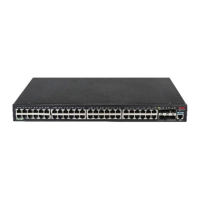65
Configuring multicast VLANs
Overview
In the traditional multicast programs-on-demand mode shown in Figure 21, when hosts (Host A, Host B
and Host C) that belong to different VLANs require multicast programs-on-demand service, the Layer 3
device, Router A, must forward a separate copy of the multicast traffic in each user VLAN to the Layer 2
device, Switch A. This results in not only waste of network bandwidth but also extra burden on the Layer
3 device.
Figure 21 Multicast transmission without multicast VLAN
The multicast VLAN feature configured on the Layer 2 device is the solution to this issue. With the
multicast VLAN feature, the Layer 3 device replicates the multicast traffic only in the multicast VLAN
instead of making a separate copy of the multicast traffic in each user VLAN. This saves network
bandwidth and lessens the burden on the Layer 3 device.
The multicast VLAN feature can be implemented in sub-VLAN-based multicast VLAN and port-based
multicast VLAN.
Sub-VLAN-based multicast VLAN
As shown in Figure 22, Host A, Host B, and Host C are in different user VLANs. On Switch A, configure
VLAN 10 as a multicast VLAN, configure all the user VLANs as sub-VLANs of VLAN 10, and enable
IGMP snooping in the multicast VLAN.
Source
Receiver
Host A
Multicast packets
VLAN 2
VLAN 3
VLAN 4
VLAN 2
VLAN 3
VLAN 4
Switch A
Receiver
Host B
Receiver
Host C
Router A
IGMP querier

